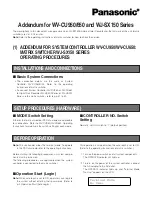
14
installation
The time a vibration must be above set point before trip occurs is individually
adjustable for shutdown and alarm from 2 to 15 seconds. To readjust the time
delay, turn the shutdown set point (or alarm set point for alarm time delay) knob
CCW until the LED illuminates. The time from this point to relay actuation is the
time delay. Change the time delay via a nylon non-conductive screwdriver. Set
CW to increase time delay (one complete turn is approximately 0.5 seconds).
Then recheck and readjust until the desired time delay is achieved.
Test Mode
The test position of both shutdown and alarm knobs is used to test the switch
functions without the need for vibration. When the shutdown knob is turned
to test, the shutdown LED should immediately illuminate, the 4-20 mA should
exceed 20 mA, followed after the delay time by actuation of the shutdown
relay. Alarm is similar, but has no effect on the 4-20 mA out.
If the shutdown or alarm knob is returned to a normal setting before the du-
ration of the time delay has been exceeded, the LED will come on without
energizing the triac.
Alarm and Shutdown Light Emitting Diodes
Since the LEDs activate instantaneously (before time delay), they can be used
to check the machines actual vibration level, i.e.; slowly decrease shutdown set
point by turning the set point knob counter-clockwise until the shutdown LED
illuminates. Note this setting and return the knob to a higher setting (before
time delay runs out). This is the actual vibration level present.
System Block Diagram
An internal transducer module consisting of a crystal assembly and integral
charge amplifier senses vibration. Thus, the electrical output of the transducer
is a well buffered (low impedance) signal directly proportional to acceleration
(G) of the switch.
The signal goes to a custom hybrid circuit to yield an A.C. signal now propor-
tional to velocity. This signal in turn is routed through an amplifier, the gain of
which is controlled by the shutdown setpoint.
Next, the signal is processed through a true RMS to DC stage and compared
against a preset internal volt age reference. If the signal level is higher than


































